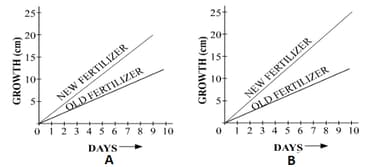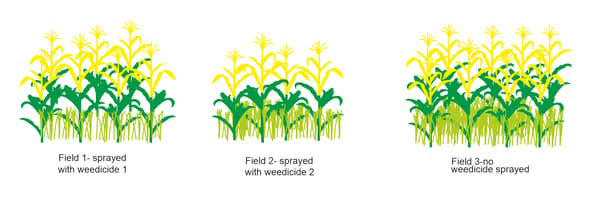Embibe Experts Solutions for Chapter: Crop Production and Management, Exercise 1: Exercise
Embibe Experts Science Solutions for Exercise - Embibe Experts Solutions for Chapter: Crop Production and Management, Exercise 1: Exercise
Attempt the free practice questions on Chapter 1: Crop Production and Management, Exercise 1: Exercise with hints and solutions to strengthen your understanding. THINK ABOVE AND BEYOND SCIENCE PRACTICE BOOKS solutions are prepared by Experienced Embibe Experts.
Questions from Embibe Experts Solutions for Chapter: Crop Production and Management, Exercise 1: Exercise with Hints & Solutions
An experiment was conducted to study the effect of a new fertilizer on the growth of two varieties of wheat. The data for growth of the plants from germination to next 10 days is shown in the figure. All other growing conditions such as water and sunlight were kept the same for both the varieties. Which of the following is the most reasonable conclusion you can draw from the data?

Nila performs an experiment with two potted plants. She keeps the pots in sunlight and waters them equally. She adds manure to the soil in Pot 1. After a few days, she can see changes in the Pot 1 plant.

What is Nila investigating?
Mohan and Sohan are farmers in Rajasthan, where there is shortage of water. Mohan waters his crops through irrigation channels connected to a tube well. Sohan uses drip irrigation. Which of them shows greater concern for the environment?
Three different cropping patterns, viz. A, B and C are applied to get the maximum benefits from a crop field. In A, two or more crops are grown together in the same field in different rows or strips. In B also, two or more crops are grown together but not in definite rows. In C, different crops are grown on a piece of land in a pre-planned succession. These cropping patterns maintain soil fertility and crop yield. Out of A, B and C which represents intercropping? Explain.
A farmer wanted to test the effect of two different weedicides on wheat production. Weedicides are chemicals that are sprayed on crop fields to remove weeds. He sprayed each weedicide on two different Fields. No weedicide was sprayed on field 3.

Why did the farmer not spray any weedicide on Field 3? What can the farmer conclude from his tests?
Rice is grown twice a year in Tamil Nadu, But it is not possible in northern part of India. What may be the reasons?
Water logging in a field is not good for plants. But in case of paddy, water logging is necessary. Why?
Had you been an advisor to the department of agricultural practices, what would have you advised the farmers for weeding their fields-chemical weedicides or biological control of weeds? Why?
